Southern Sri Lankan traditional artistic curative practice contains an amalgamation of numerous artistic practices. A branch of the performing tradition includes textile and costume making diversified regionally in the form of ritualistic “Thovil” or exorcist practices to other forms of “Shanthikarma” or curative variants containing diverse attire aesthetics ( distinctive regional branches of the performing arts prevailed in the southern parts of Sri Lanka, which are Bentara, Matara, Raigama )
The name “ KAGUL” is the ornated headwear worn by the head healer or the “ Adura” ( Sinhala term for the healer). The performers wear this symbolic headdress as a crown that provides a form of elevation from their social upbringing as a marginalized lower caste body.
KAGUL is a platform that aims to rejuvenate a dying traditional textile practice, bringing its talismanic form and its historical and cultural representations to contemporary times. Aspects of its timeless approaches are to be redesigned, revoke new nuances in approaching the tradition, and find deeper roots of its existence. To create a discourse by analyzing and decoding the existence of its gendered cultural identity, representation, and histography through the textile tradition.
Research and discourse of KAGUL.
One of the ceremonial attire created by the artist Somapala pothupitiye
Pothupitiya family (mentors Somapala and Pala Pothupitiya) falls under the region of Matara (an area in Sri Lanka) district of Southern traditional artisan communities of the “Navandanne” lineage ( Navandanne, artisans who have mastered thoroughly nine distinctive craftsmanship including metal, jewelry, textile, and wooden, architectural, curative, medicinal, performing arts). They have been generationally practicing and carrying this Curative tradition within their subaltern communities of Sri Lanka. They are passing on the tradition from father to son, existing within the domains of the patriarchal inheritance.
With each encounter with the master artisans of the Pothupitiya family, a conversation was developed to rediscover the technicalities, oral histories, cultural representations, and colonialist influences on the southern traditional artisans. Multifaceted realities, formations, interpretations, and ethnographical studies on the islander’s practices, lifestyles, and socio-political attributes were also part of the subjectivity.
Southern performative rituals prevailed as two distinguished sections; “thovil” or exorcist rituals and the other “shanthikarma” curative healing processes. The “Aathuraya” known as the ill person or the victim and the “yakadura” also known as the head of the healing ritual, are the two distinctive characters of this process, apart from the performers taking roles of demonic entities. The exuberant process of ritualistic practice allows the healer to heal the ailed being physically and psychologically. Step-by-step ambiances, bodies, and souls transcend into the liminal realm. The patient and the observers gradually engulf the liminal world of supernatural entities, where demonic and divine forces ( forces of nature) exist in constant struggle and balance.
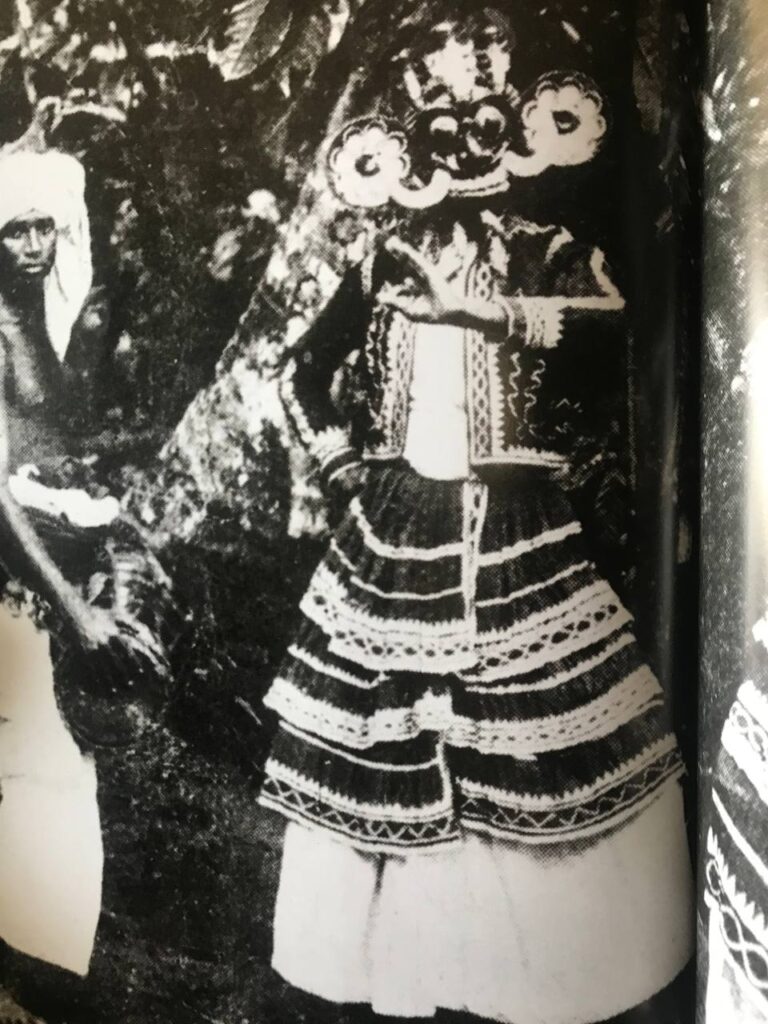
Documented from the archive material shown at the public view section at Ambalangoda Mask Museum , Sri Lanka.
The tovil (curative rituals ) , which are dying form of art within Sri Lanka (due to prevailing as inherent practices and lesser funds , support given by the state ) can defined under three separate categories. Yak Tovil ; to prevent harmful and evil acts by demons , Deva Tovil ; to invoke blessings of the deities and Bali Tovil to ward off adverse effects of the nine planets ( Nava graha , deities of cosmic realm) during periods of misfortune. The performers , Conductor ( called as Yaka dura, Kattadiya or Yak dessa ), Kapurala or pattini hami ( chief priest in Deva Tovil ), the conductor in charge of Bali Tovil is known as Bali Adhura,Bali gurunnase or Sittara gurunnase . Each performer wears a poignant dress code , attire which distinguish their roles. The ornate beaded textile traditions prevail heavily within the Matara sector of this traditon. The necklaces, jackets, waist bands, Kaagul (intricate crowns) adorns the performer as well as carry ritualistic symbolism of healing as well as patterns distinguish Dhamma and cosmology. Even though we witness some of these attributes in Raygama and bentara branches , there are many heavy variations .
These artisans falls back under the Karava caste or other lower castes according to the earlier prevailed feudal system. It was mandatory for the kings to support and create sustainability to these artistic practitioners; which caused for these families to continue these practices within inherent structural basis.
The ritual process is carried out vertically from the lowest to the highest beings under each watch of time. Past midnight to the break of dawn is considered the peak time for demonic entities in their highest form. ( few demon characters even harbinger in the noon, twilight, or secluded spaces). The ritual ascends gradually, according to the cosmic hierarchy of order within the liminal world interconnected by the performative space. Create a form of trans ambiance during the entire act, shifting from its symbolic elements.
The attire or the ceremonial costumes worn by the “Yakadura” main healer, also known as the “Adura” or the leader, must have the ability to connect with the liminal world. The performers, therefore, transcend into a singular being with the cosmic entities during the performative space.
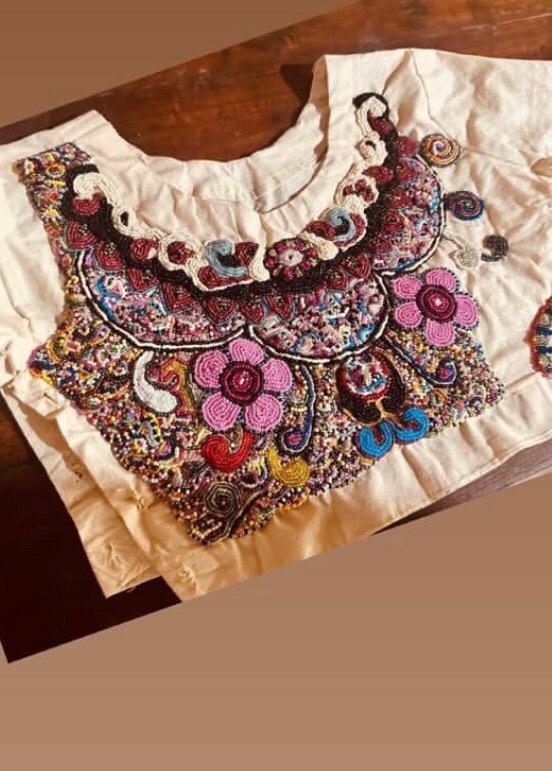
Ceremonial short sleeved jacket embroidered with talismanic patterns.
Textile patterns of the ceremonial attires contain rhetorical embodiments of healing and talismanic notions beyond mere decor. They exist to ward off negative/evil elements and interconnect the body with the liminal realms. The artisans must constantly carry out the precision of following these rhetoric to be communicated through the attires while making. There are hybrid entanglements within these performative practices that branched out to south Indian cultural attributes to influences of institutional Buddhism and Eurocentric colonialism.
Disembodying each pattern and symbolism, one must attest that connecting with the branches towards the Thervadic Buddhism affluence branch shows interpretations of ‘Abhi dharma’ (philosophical discourse of meditative practices that exists in the teachings of Buddhism ).
Some symbolical patterns indicate three liminal worlds, flora, and abstract patterns culminate energies within these cosmic plains. Other patterns interpret through forms and colors about ‘Arya ashtangika margaya’ ( path to enlightenment), Pancha butha ( five elements) considered apo, thejo, vayo, and patvi. These five elements combine to harness the formation of living and nonliving entities accordingly.
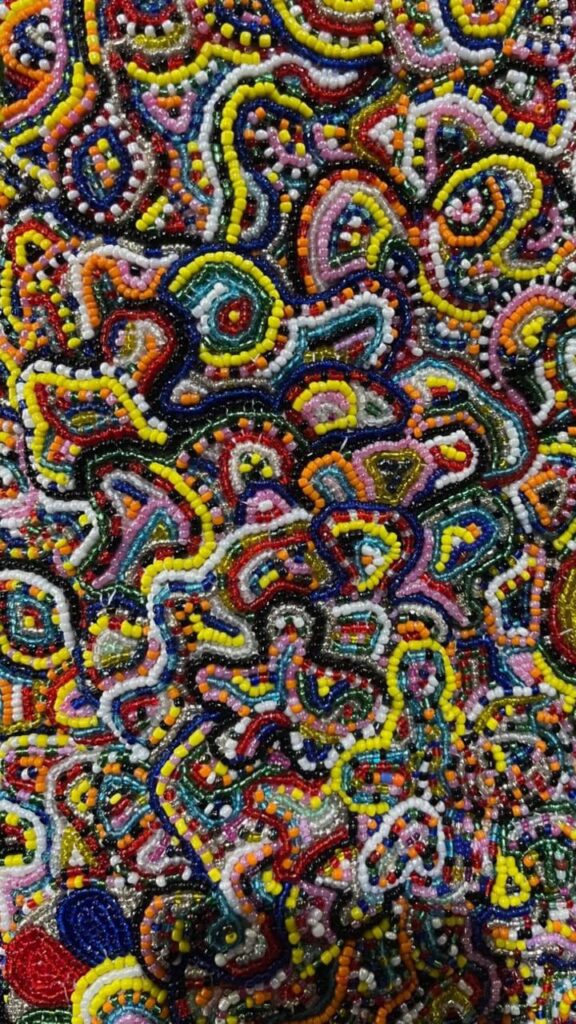
Within these teachings of Abhidharma, there is a hidden contextual integration of queer existence dormant within its cosmological interpretations. The soul has been moving as a transgressive, biomorphic energy source. Relentlessly transcends according to energy accumulations, contributed by ‘ Karma’ ( deeds ), creating a being devoid of structuralist counterparts.
This theoretical premise is called the “ Anathmavada” ( soul has no distinguish form as a constructive individual being called “ I” ) and leads on to a significant theoretical backdrop that lays the foundations for a queer discourse within the textile interpretations itself. This premise led to the culmination of a multifaceted of interpretations and discoveries to disclose the existence of bodies that have been segregated, erased, or perhaps never embraced as part of the larger narrative of cultural histography.
Another head gear worn by the performers created by Somapala Pothupitye
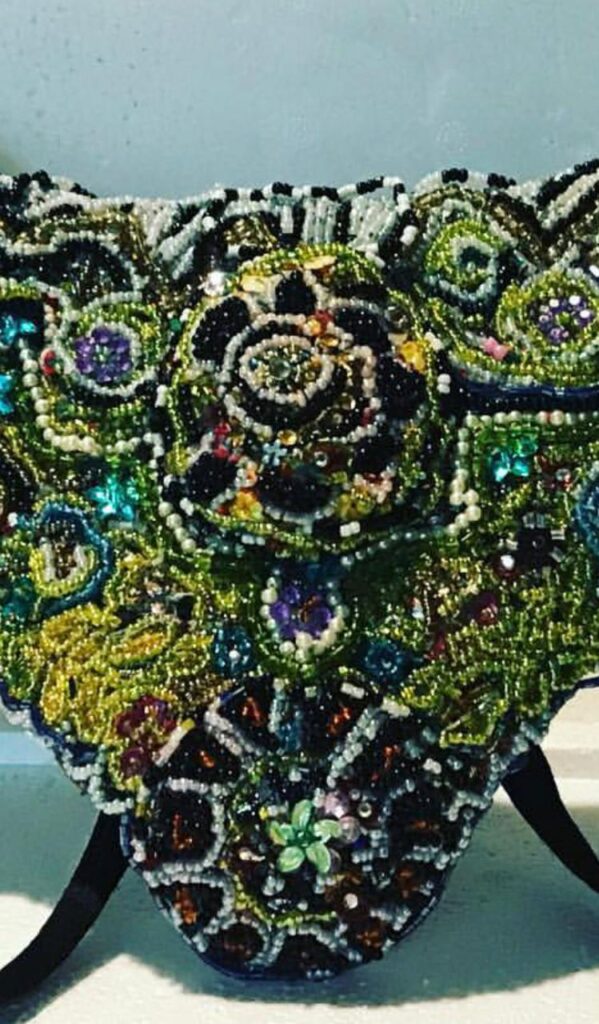
Details of the embroidered patterns
Three belts combined to hold above the waist band, heavily embroidered with talismanic patterns. They are worn over the white loin cloth called ” Sarong”.

Details of one waist belt with a frilled formation.
KAGUL ( Head dress worn by the performer or the ” ADURA” or Healer)
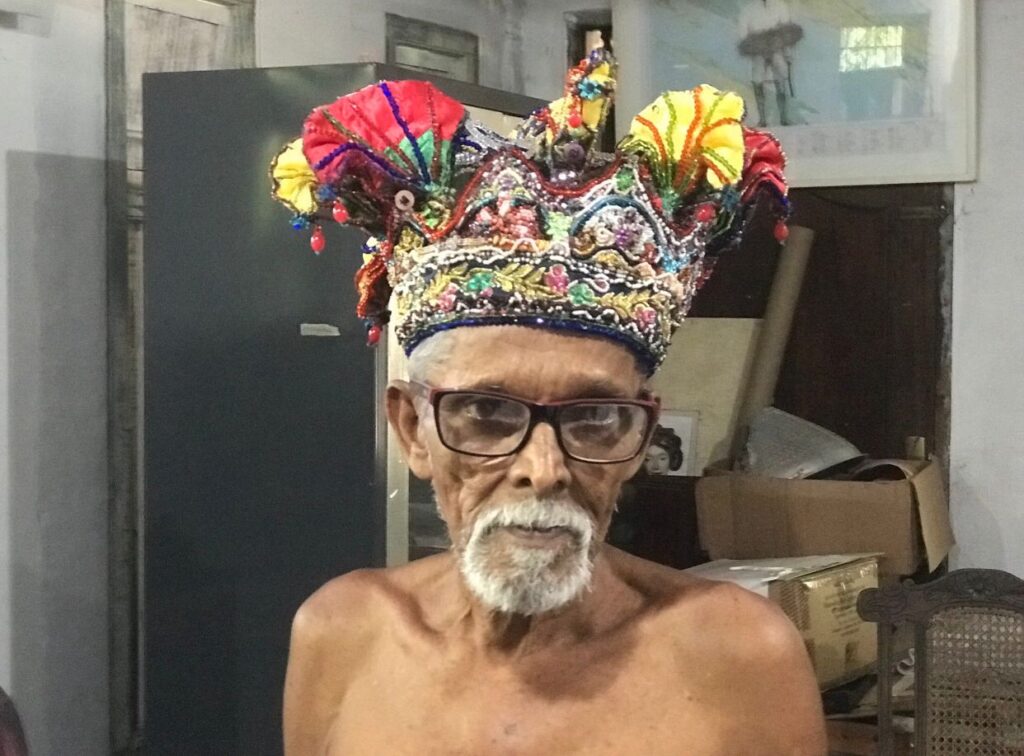
KAGUL is the term which recognize the headgear worn by the performers or the head healer. The structure of the crown resembles to a Juan Toppiya which is been worn by the Portuguese and Dutch as per reference material we have gathered. There are elements which symbolizes transcendence and elevation of the performer when they wear the headgear.
A crown with four sides symbolizes ” Chathur Arya Satya” ( These are called “Four eternal truths” in Abhidharma , “Dukka”( pain of suffering) , “Dukka Samudhaya (origin of pain), “Dukka Nirodha”( realizing the origin of pain) , “Dukkagamini Pattipada Arya Satya “( pathway to release from pain ). Then if eight sides are added in this crown would means a person following the pathway of release from the origination of pain or pathway to nirvana/enlightenment called ” Arya Ashtangika Marga”.
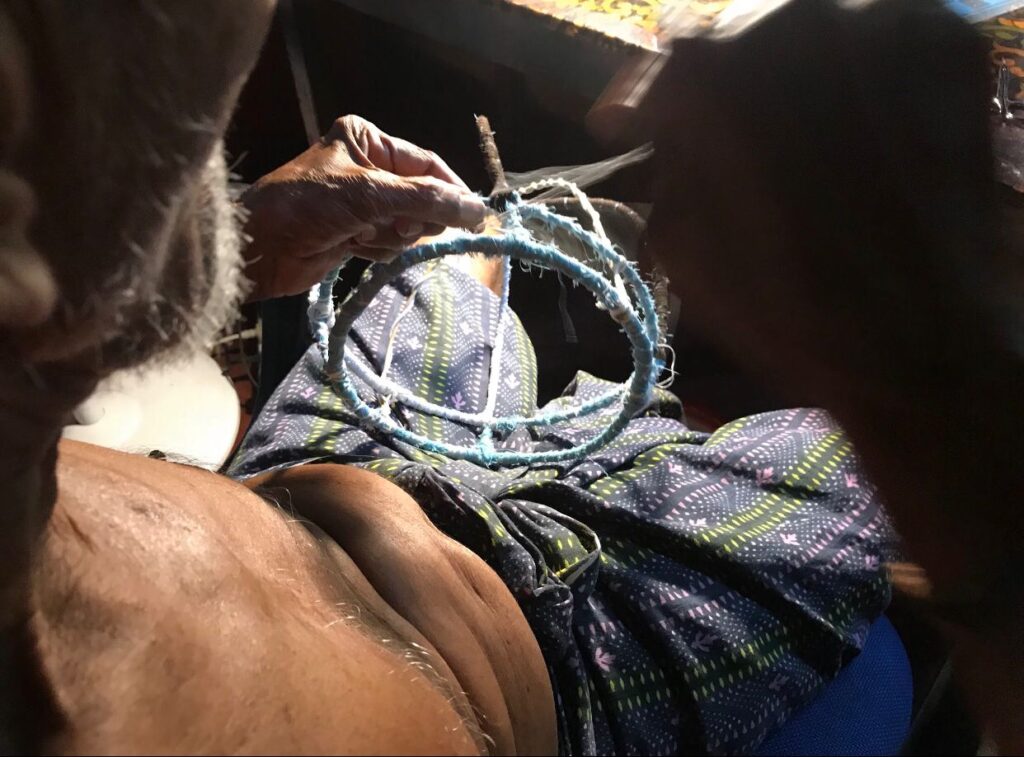
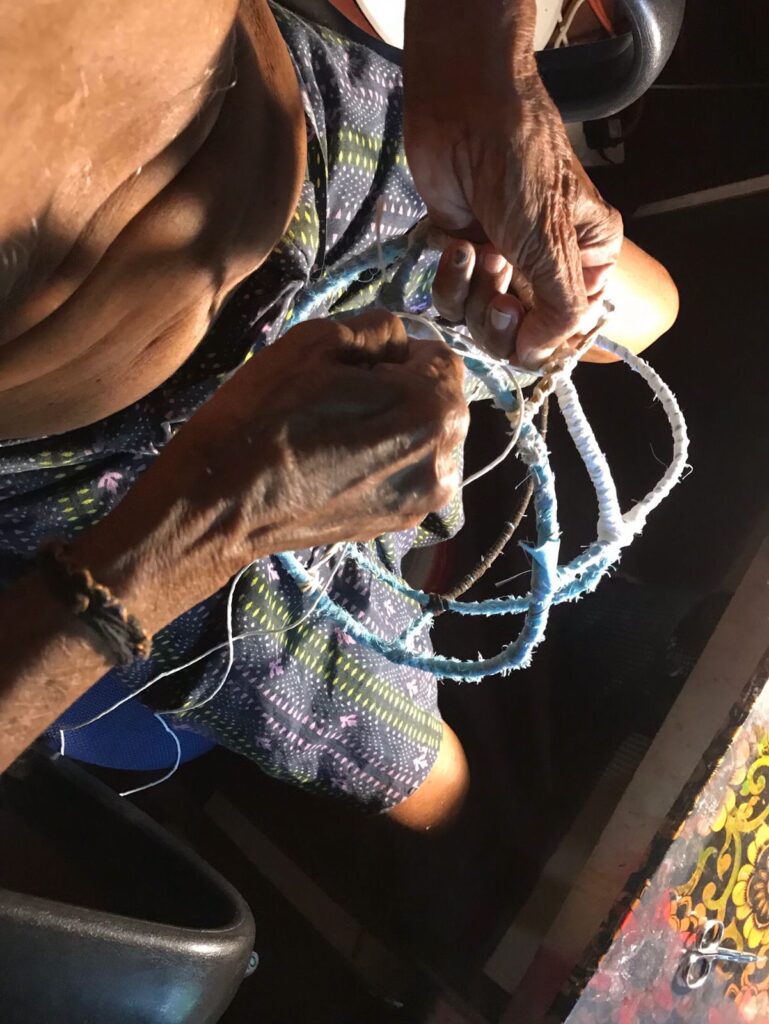
After constructing the ornate base of the crown wrapped with discarded cloth , beading the talismanic patterns begins over this construction.

Glimpses of the attires documented in the 767th Dewinuwara procession ( year 2024), performed in the month of August ( this month is also called Asela according ritualistic calendar). This Procession is performed as a form of receiving blessings from the guardian god ” Vishnu” or “Upulvan”. You can visibly observe that the present costumes have particular variations and perhaps changes indicating the lack of the intricate talismanic patterns. Materials of the crowns have gradually changed to paper and plastic, due to lack of skilled textile makers who have retained the traditional embroidery making.
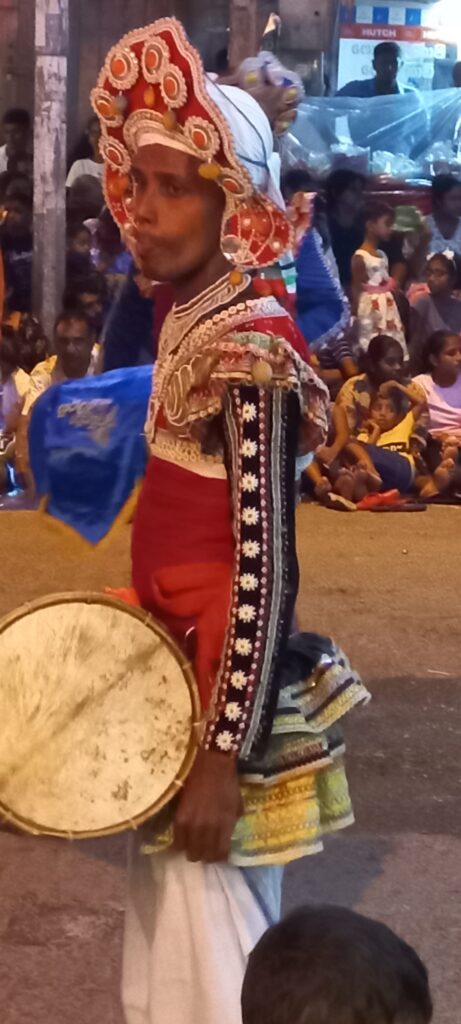
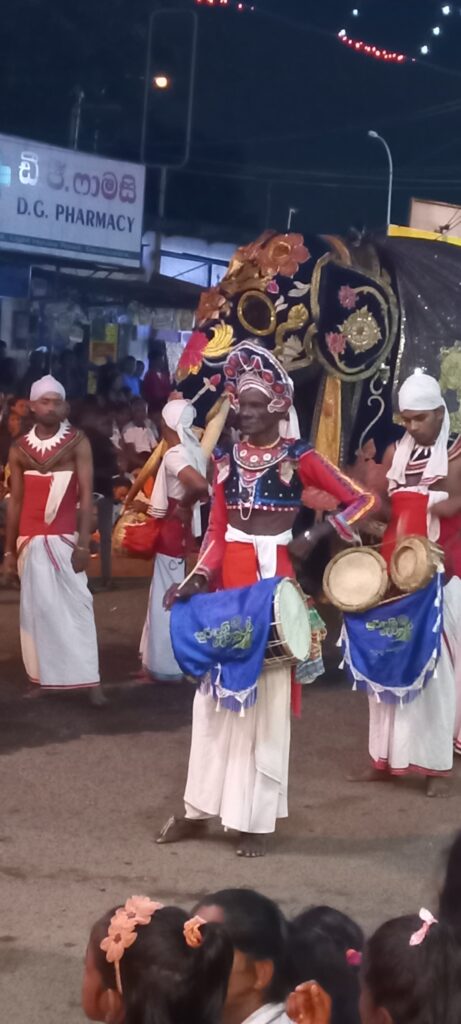
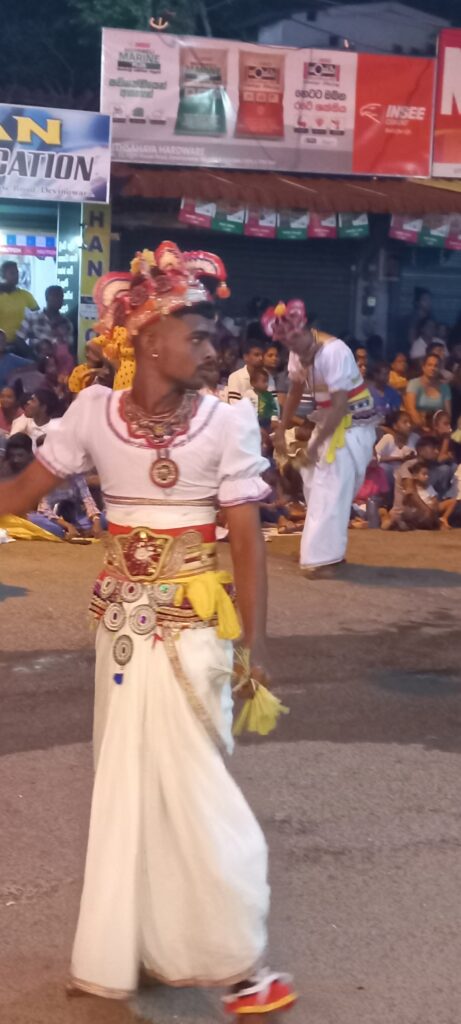
Introductory video on KAGUL initiative.